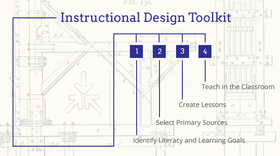Primary Source Exemplar: The Moon
Procedures
A. Refer back to the previous lesson on archeology [The lesson with the 2-liter bottle with buried artifacts, diaries, and poem]. Write sentences on the board that describe the students’ days and activities. Keep a collective diary of the previous day[s] together. This is a class diary, you can call it “Our Class Diary." Discuss why scientists and other people keep diaries.
B. Review with students how we learn about history. Ask, “How do we know about people from the past?” (If they don't mention diaries, prompt). You could also show a copy of Diary of a Wimpy Kid, or another diary you may have used in the last lesson.
C. Discuss again why diaries are important for history - why we keep them. Tell them that many important people keep diaries. Some important people, like the President of the United States, have other people who keep a diary of activities for them - like a secretary keeps track of appointments.
D. Give each student (or display on the board or overhead) - a copy of the Nixon diary for the day of the moon landing. http://www.nixonlibrary.gov/forkids/speechesforkids/moonlanding/dailydiary07201969.pdf [July, 7th, 1969 at 11:45pm]
E. Say, “Look what I have here." Allow time for them to reply. They may not be able to read it, but some may, so see what they come up with first.
F. Next, read different lines of the diary, including the title. Before you get to the part where President Nixon writes about his moon landing call, ask them: Who do you think this is about? Who do you think wrote it? Why do you think that? [Ask these after you read…to engage them in the information]
G. Help students “unpack” the document by having them listen to the words, look at the official looking document, find clues to tell them that it’s from the president of the United States.
H. Then explain briefly that Nixon was president at that time. Help them activate their background knowledge by asking them who our current president is and what is the job of the president.
I. Continue reading the list in Nixon’s diary and then read the line about the moon. Ask: What happened on this day that was important? Why do you think that this is written like something that was “ordinary?"
J. Explain that all papers about, or written by the president of the United States, by law have to be kept in the Library of Congress. So we have good records about what they do every day. Ask if the entry in President Nixon’s diary was detailed, or not too detailed? Ask if they think we can find out more details from other sources.
K. Explain to the students that you have a recording of the radio broadcast from the day of the moon landing. Instruct students that as they listen to the broadcast, you want them to pick out the details that they didn’t find in President Nixon’s diary about the actual moon landing. Play the audio clips of the moon landing http://www.nasa.gov/mission_pages/apollo/apollo11_audio.html [On this webpage there are several places to click for different audio. Start with “We have a Liftoft” and then go on to “The Eagle has Landed”]
L. Discuss the primary source (radio broadcast). Have students pose questions as well as answer each others' questions about new details they learned about the moon landing from the radio broadcast.
M. Review and introduce student task: “We have talked about the moon landing and how important it was for our nation to land on the moon. Now I would like to know your thoughts." Discuss the responses and record student comments on chart paper.
N. Check for understanding by having students draw a picture of what they think it must have felt like to watch people walk on the moon in 1969. They should write one or two sentences describing their picture using words from the moon vocabulary on the word wall.
Independent Practice
- To assist with the homework activity, you may want to give each student a page from the president’s diary to take home. This can be the page from the day that they were born, or near to it if the specific date is not available. President Bush’s diary can be found here http://millercenter.org/scripps/archive/documents/ghb/diary). However, they will be able to complete the task without the page, as they could use a recent event that was in the news as a reference.
- Parents and child will read aloud this online book, What Does the President Do? as they look at the pictures- http://teacher.scholastic.com/commclub/president_activity1/ Reading this book will help students better understand some of the responsibilities and duties of a president.
- After students read the online book with their parents, their task will be to draw a picture of something a president has done during their lifetime and write one or two sentences below their drawing to describe what the president did.
